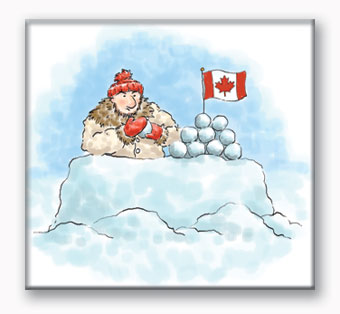Let’s melt these nationalists’ cold, cold hearts and build an Arctic circle of cooperation.
Retreating ice briefly turned the Arctic circle into an island paradise of sorts for modern-day ’49ers of all stripes and nationalities. As summer 2008 ended, the fabled Northwest Passage—the route through the Arctic Ocean at the northern edge of the American continent—was open and navigable again for the second year in a row, and, more surprising, chilly Siberia’s northeastern passage was open, too—turning the Arctic into an island perhaps for the first time in recorded history.
Turning Arctic lemons into slushy lemonade, the possibility of increasingly longer periods of Arctic islandization is good news for a hard-pressed global shipping industry during a time of rising fuel costs. The Arctic alternative route could potentially cut travel time and shipping costs in half. But the big melt promises an even greater bounty to the Northern Hemisphere’s shivering brotherhood of nations.
Denmark, Norway, Canada, the United States, and Russia are among the lucky few hoping to capitalize on the planet’s first global-warming resource rush. Denmark plans to claim miles of Arctic turf adjoining Greenland, and the Canadians are spending $100 million to map out the region’s energy and mineral resources.
The Russians recently staked their claim—literally—by planting the federation’s flag on the Arctic Ocean’s frigid floor during a polar “research” mission last year that had about as much to do with real science as Japanese whale-eating experiments. About the only folks left out of the snow rush are the Inuit people who might actually have a legitimate claim on these icy reserves of fossil fuel and lucre-ish minerals. Don’t the Eskimos have 200 words for avarice?
You might think that confronting the many calamities proffered by our globally warmed future might provide the nations of the world with a beatific opportunity for cooperation and consultation. Instead the melting of the great white north apparently has only encouraged the planet’s political leaders to find new ways to heat up a really cold war in an unseemly stampede to seize the natural gas, oil, gold, and other mineral resources slowly being revealed by melting ice.
The Arctic’s neighborhood of turtlenecked powers are worried enough about each other’s intentions to start building bigger and better-armed ice breakers to make sure the Arctic’s resource wealth gets “fairly” distributed to their national refineries and mining conglomerates. America’s aged fleet of three icebreakers is now in line for a refresh, and Canada has committed billions to build a new fleet of armed Arctic patrol vessels to enforce its 200-mile water grab.
One can only hope cooler heads prevail before raging northern nationalists get much more hot and bothered. That’s looking less likely as the water and the rhetoric heat up, but there’s still a chance the Arctic powers can come together and develop a rational consensus on how to respond to the pole’s shrinkage problem, much as the potential ring of martial fire around the South Pole dissipated after international agreements turned Antarctica into a global research project instead of an icy turf fight.
It is a painful irony that it is precisely a global warming-fueled melt-off, the product of our extravagant exploitation of the planet’s finite energy resources, that is allowing the despoiling of the Arctic and well, let’s face it, even more extravagant burn-offs of energy resources. Hmmm, what can we melt next?
Good global stewardship would seem to argue for a judicious exploitation of the planet’s exquisitely finite fossil fuel resources. Instead we’ve indulged in a frenetic consumption of millions of years of creation in just a century and a half.
Don’t we owe it to the future to leave a little bit behind, at least enough to display in a modest Climate Change Museum adjoining the steamy North Pole Beachfront Hilton Hotel and Casino when it opens in 2045?












Add comment